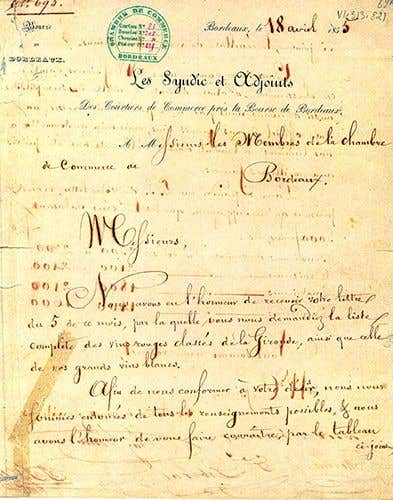Bordeaux 1855 Classification


The crème de la crème of the grand vins of Bordeaux are known as Grands Crus Classés, which refers to the wine included in the 1855 official French Government classification. For over 160 years, this classification has remained the gold standard of French wine. Critics of the classification have valid complaints that important and delicious appellations like Pomerol and St. Emilion were not included, however, efforts to reform the 1855 classification have not gained traction.
While admittedly imperfect, the classification has stood the test of time and represents the standard bearers of quality Bordeaux. These classified wines serve as a benchmark for global wine makers, especially the top-notch New World wines produced in California, Australia, and South America. A wine aficionado is likely to develop a lifelong love for Bordeaux, which passionate fans have described as drops of wonder made by man and nature.
Bordeaux, as a wine making region, dates back to its formative days when Romans planted vines and made wine. The watershed moment in Bordeaux history was the 1855 official Bordeaux classification of the Médoc and Sauternes (Grands Crus Classés en 1855 Médoc & Sauternes). Even though Médoc is but one of many wine making regions in France, the official classification was requested by Emperor Napoléon III on the eve of the Universal Exposition in Paris (1855 Exposition Universelle de Paris) to showcase the best wine made in Bordeaux.
The 1855 Classification grouped the best Bordeaux wine into five crus. The most natural English translation of crus is growths. However, the word growths can be misleading if one is led to think of the grapes growing at different time or stage. Rather, growths are better interpreted as a polite way of saying quality levels.
At the time, wine within the same cru was considered to be equal to its peers. Sadly, that has not rigidly remained the case. Over the past 160 years, some Chateau’s have seen their fortunes rise and fall with family successions, economic crises and war. Even the outbreak of phylloxera has led to the deterioration (some say near-destruction) of various estates at times. Fortunately, wine making has grown as a scientific art since the 1950s, introducing improvements in production that have returned many classified growths to their glory. To the educated buyer, this means they have the opportunity to both enjoy the classics and the fun of seeking out wines that have evolved their palate-pleasing qualities.
As the map indicates, Bordeaux benefits from its unique geographical location that sets it apart from other wine-producing regions. Bordeaux is located on the 45th parallel, mid-way between the Equator and the North Pole. To its immediate west is the Atlantic Ocean. To its east is the dark and dense Landes Forest. Bordeaux graces the paths of three roaring rivers – the Gironde, the Garonne and the Dordogne. Multiple smaller waterways snake their way across this region as well. The bodies of water, coupled with the forests give Bordeaux a fairly moderate, maritime climate is a key component of its terroir. Moderate weather, gently sloping vineyards, and heavily graveled soil are key to the region’s success.
